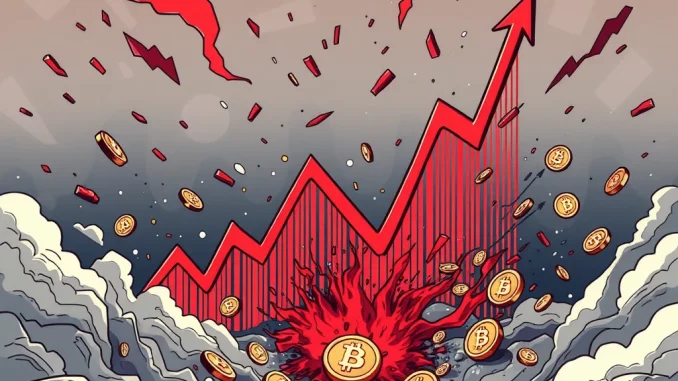
The world of cryptocurrency can be exhilarating, but it also carries significant risks. The recent, brutal ZKJ token crash serves as a stark reminder of just how quickly things can go wrong. On June 15, holders of Polyhedra’s ZKJ token watched in dismay as its value plummeted by over 80%. What caused such a dramatic collapse? The team behind Polyhedra has released a report shedding light on the events, pointing to a confluence of factors including a coordinated on-chain liquidity attack, significant movements by large holders like Wintermute, and market dynamics like cascading liquidations. Let’s break down the key findings from their report.
Unpacking the Brutal ZKJ Token Crash
Polyhedra Network is known for its work in zero-knowledge proofs and interoperability solutions, aiming to connect various blockchain networks. Their native token, ZKJ, plays a role within this ecosystem. However, the project faced a major crisis on June 15 when the ZKJ token experienced a rapid and severe price decline. This wasn’t just a minor dip; it was a full-blown crash that wiped out the majority of the token’s value in a very short period.
According to Polyhedra’s analysis shared on platform X, the crash was not a single isolated event but rather the result of several interconnected pressures hitting the market simultaneously. Understanding these factors is crucial for grasping the complexities of decentralized finance and tokenomics.
The Anatomy of a Crypto Liquidity Attack
One of the primary triggers identified by Polyhedra was a coordinated on-chain liquidity attack. What exactly does this mean?
- It involves malicious actors or groups strategically manipulating liquidity pools on decentralized exchanges (DEXs).
- In the case of ZKJ, the attack began with significant withdrawals from a key liquidity pool – specifically, the ZKJ/KOGE V3 pool on PancakeSwap.
- Removing large amounts of tokens from a pool reduces the available liquidity, making the token’s price extremely sensitive to subsequent trades.
- Following the withdrawals, aggressive selling (dumping) of ZKJ tokens commenced. With less liquidity to absorb the sell orders, the price dropped precipitously with each sale.
This type of attack exploits the mechanics of DEX liquidity pools to force a token’s price down rapidly, often enabling the attackers to buy back the token at a much lower price or profit from short positions.
How PancakeSwap V3 Amplified Volatility
The report specifically mentioned the PancakeSwap V3 pool and its role in exacerbating the price collapse. PancakeSwap V3 introduced concentrated liquidity, allowing liquidity providers (LPs) to allocate capital within specific price ranges rather than across the entire price spectrum.
While this can increase capital efficiency for LPs within their chosen range, it creates vulnerabilities:
- **Reduced Stability:** If the token price moves outside the concentrated range, the liquidity available at the current price point becomes very thin.
- **Amplified Swings:** Thin liquidity means even relatively small trades can cause large price movements.
- **Impact of External Factors:** Polyhedra noted that the stability of the ZKJ/KOGE pool had already weakened in early June after Binance reduced Alpha farming rewards, which likely impacted LP behavior and where liquidity was concentrated.
Once the aggressive selling pushed the ZKJ price out of the concentrated liquidity range on PancakeSwap V3, the lack of depth outside that range meant the price drop was amplified, creating a vicious cycle.
Examining Wintermute ZKJ Deposits
Adding fuel to the fire were significant movements by large holders. The report specifically highlighted that during the rapid price decline, Wintermute, a prominent crypto market maker and trading firm, deposited over 3.39 million ZKJ tokens onto centralized exchanges (CEXs).
While depositing to a CEX doesn’t automatically mean selling, large deposits during a crash are typically interpreted by the market as an intent to sell or as preparation for selling. This influx of potential sell pressure onto exchanges where trading occurs further increased the supply available for sale at a time when demand had evaporated, adding significant downward momentum to the ZKJ token crash.
Market Maker Efforts and Cascading Liquidations
In an attempt to stabilize the situation and counter the intense sell pressure, Polyhedra’s market makers deployed substantial capital. They injected approximately $30 million worth of stablecoins (USDT, USDC) and BNB into decentralized platforms.
However, the speed and severity of the crash overwhelmed this effort. The deployed capital was rapidly converted into ZKJ tokens as people sold, effectively adding to the buying pressure but unable to absorb the sheer volume of selling occurring across multiple platforms.
Compounding the problem, the rapidly falling spot price triggered a wave of forced liquidations. Many traders use leverage on platforms like Bybit to take larger positions than their capital allows. When the asset’s price drops significantly, these leveraged positions fall below the maintenance margin, and the platform automatically sells the user’s assets to cover the debt. These forced sales add even more sell pressure to the market, accelerating the price decline in a phenomenon known as cascading liquidations.
Lessons from the Polyhedra ZKJ Incident
The events surrounding the Polyhedra ZKJ crash offer several important takeaways for the crypto community:
- **Liquidity Risks:** Concentrated liquidity models, while efficient, can lead to extreme volatility when prices move out of range.
- **Market Maker Limitations:** Even significant capital deployed by market makers can be insufficient against coordinated attacks and widespread panic selling.
- **Whale Movements:** Large deposits by major players like Wintermute can heavily influence market sentiment and price during volatile periods.
- **Leverage Danger:** Cascading liquidations from leveraged positions on CEXs can dramatically worsen a price drop.
This incident underscores the need for robustness in DeFi liquidity pool designs and highlights the inherent risks associated with token price stability in the face of determined market manipulation and unfavorable conditions.
Conclusion
The ZKJ token crash on June 15 was a complex event driven by a combination of factors: a targeted crypto liquidity attack on DEXs, vulnerabilities in concentrated liquidity on PancakeSwap V3, significant ZKJ deposits by Wintermute onto CEXs, and the subsequent cascade of liquidations on leveraged trading platforms. While Polyhedra’s market makers attempted to intervene, the coordinated selling pressure proved too strong. This incident serves as a critical case study on the fragility of token markets under duress and the powerful interplay between on-chain activity, CEX trading, and market sentiment. Investors and projects alike must consider these multifaceted risks when participating in or building within the crypto ecosystem.



